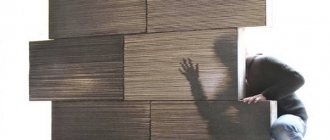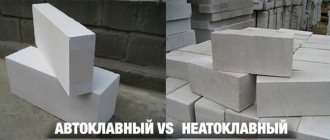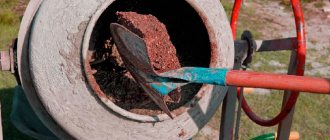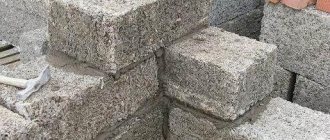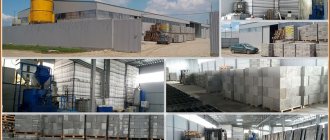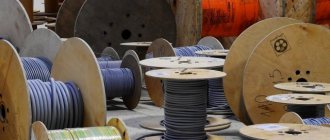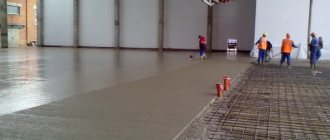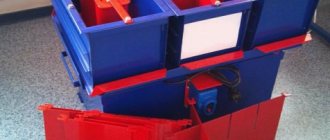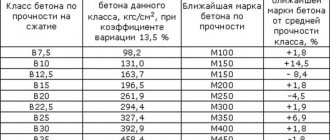Washed concrete is a modern technology for manufacturing decorative products from ordinary general construction cement, coarse and fine filler. Initially, the “washed concrete” technological process was developed and implemented in the United States of America and the countries of old Europe.
Subsequently, thanks to its uniqueness, washed concrete became and continues to become widespread in the CIS countries: the Russian Federation, Ukraine and Belarus.
Application area
This type of structural and building material is 100% used in the production of decorative concrete products. In particular, washed concrete technology is used in the construction and production of the following products and structures:
- Decorative tiles for finishing the local area.
- Making outdoor flowerpots and plant pots.
- Production of outdoor tables, benches and other garden furniture.
- Production of tiles for finishing the surfaces of load-bearing walls.
- Production of slabs for arranging garden paths.
Washed concrete is a unique decorative and finishing material, therefore it is used exclusively for decorative purposes. Washed concrete is not used for the construction of load-bearing concrete structures.
Where is washed concrete used?
The number of fans of washed concrete is growing from year to year. It is used to decorate garden plots, residential premises, offices, and car areas. Characteristics and special resistance to negative temperatures allow it to be used:
- during the construction of blocks for retaining walls;
- cladding of internal and external wall ceilings;
- for the manufacture of pots, flower beds, flower beds, steps, columns, canopies for fences, street fountains, tables, benches;
- areas for cars;
- laying paths in the garden;
- trash cans, barbecue areas;
- tree trunk circles;
- blocks for balcony screens.
The technology for producing such concrete differs little from the method for producing standard concrete products. The whole process: the components are mixed in appropriate proportions, poured into a mold, treated with chemicals and hardened. The result is a very beautiful plane, reminiscent of natural stone, and each product is individual and unique.
Equipment and materials
The composition of washed concrete includes the following components:
- Portland cement. It is a hydraulic binder consisting of calcium silicate and its derivatives. It is plastic, durable, and hardens quickly. For the production of washed concrete, the inexpensive brand M400 (M400 d20) is suitable. Proportions - 1 part of the total volume.
- Aggregate. Pebbles, crushed stone (fractions 5-20 mm), glass beads or crumbs, granite, marble, dolomite, smalt, cast iron shot, waste from thermal power plants are used. The size and amount of material depends on what effect you want to get in the end. Proportions - from 1 to 3 parts.
- Sand (preferably river sand). Proportions - 1-1.5 parts.
- Water.
- retarder or special paper impregnated with chemical reagents.
Retarders reduce the setting time of concrete and have a positive effect on strength. The most commonly used are the following: Peramin R, Cementol Retarde, G-05, Peramin R, RSB-500, Sementol Retard, Addiment VZ 2, Zika Retard. You can, as a last resort, add whey and even feed sugar molasses.
Equipment you will need:
- Container in which the solution will be mixed.
- Spray gun. You can use a water pump, and if you are making a garden path, a simple whitewash pump will suffice.
- Sprayer , with which the retarder will be applied and a shovel to transport the mixture into the mold.
- Concrete mixer . You can mix concrete by hand, but it will be a complicated, long process. Therefore, it is best to work with your hands if you need a small amount of mixture. If the solution is being made for a large structure, use an inertial concrete mixer (“pear” is not suitable here). Mobile devices help to evenly distribute the components in the mixture and are convenient for making small batches.
- Forms . They can be made to order from metal (using your own template), or you can buy regular plastic ones in the store. The first ones, naturally, will last much longer.
- You can use a vibrating table and a trowel to level the surface.
Are you planning to buy or make your own washed concrete?
Sequence of work
At the first stage, you need to prepare a concrete mixture by mixing all the components. It should be of medium consistency: not liquid, but not thick. For small-sized elements, the mixture may be slightly liquid, but for concreting an entire site it should be made denser.- A wooden formwork or a plastic matrix must be ready (for the manufacture of a large product, a supporting frame is installed). Apply a retarder to the bottom or place special paper. The concentration of the gel depends on the ambient temperature: ideal values are within +20 degrees. It may also take more or less time: for example, the G-05 deactivator hardens for at least a day.
- Pour the concrete mixture into the mold and sand the surface again. It is most convenient to apply the gel with a wide brush or a thick roller. It is at this stage that the vibrating table comes in handy.
- Remove the mold from the table and leave to dry.
A vibrating table helps produce a more durable product. The number of small voids will be reduced to a minimum; therefore, air will also be kept to a minimum; water will have nowhere to linger. The risk of expansion and rupture of concrete due to temperature changes will be minimized.
If you want to create a product with a special pattern, apply the deactivator not only to the walls of the mold - immerse it in the gel after the workpiece has dried. This is often done, for example, with flowerpots, achieving different designs, colors or textures. Decorative elements of stairs or paving slabs can simply be coated with a retarder on the outside.
Demolding process
You can remove the product from the mold only after it has completely dried. If you do this too early, the filler will begin to spill out of the concrete mass, and if you wait, the mass will dry out and it will be difficult to remove it. Follow the deadlines specified in the instructions. For small products, the mold is removed after about a day, for large ones - after at least 40 hours.
Washed concrete production technology
The technology for the production of paving slabs from washed concrete, flowerpots from washed concrete and other products from washed concrete is based on creating conditions when the main, inner layer of the product sets and hardens much faster than the top, decorative layer.
In this case, the concrete for the inner layer is prepared according to the standard recipe of heavy concrete based on general construction Portland cement CEM I 32.5N PC (M400) or CEM I 42.5N PC (M500), sand, water and aggregate (crushed granite, pebbles, gravel) with a fraction size of 10-20 mm.
The concrete mortar for the outer layer is prepared on the basis of standard Portland cement grades TsEM I 32.5N PC (M400) or TsEM I 42.5N PC (M500), clean sand and decorative filler for washed concrete: quartzite, marble chips, river or sea pebbles, small multi-colored granite crushed stone, dolomite, beautiful multi-colored gravel.
The “highlight” of the technology is the treatment of the outer layer or surface of the form for pouring with a special substance - a retarder for washed concrete (deactivator) of concrete hardening. For example, a gel retarder for washed concrete “Setting retarder for the surface layer of concrete Bisil Retarder SF”.
The retarder for washed concrete penetrates into the “body” of the decorative layer to a depth of up to 8 mm and creates conditions for “washing out” the decorative layer of concrete with a stream of water to the specified depth without destroying the concrete structure or product.
The result of treating an uncured layer of concrete with a stream of water is the washing out of the binder solution and the “exposure, drawing” of particles of decorative aggregate. Planters made of washed concrete, flowerpots made of washed concrete, tiles, fence blocks made of washed concrete, pillars made of washed concrete, slabs of garden paths and other concrete products acquire the relief, decorative and presentable appearance of “natural wild stone”.
Accordingly, the appearance of the final product made using washed concrete technology is influenced by: the size of the decorative filler fraction, the color of the filler elements and the depth of “washing”.
Therefore, if the task is to produce exclusive “washed” concrete products, you should use multi-colored fillers, it is best if it is a special mix consisting of: marble chips, fine granite crushed stone, sea or river pebbles, small gravel.
What you need
To make washed concrete, we need the same components as for regular concrete, but there are a few nuances.
How much does a cube of concrete weigh?
A rough surface is obtained as follows: lay concrete as usual, and then wash out the thin top layer of cement-sand mortar so that the stones are partially exposed. This cannot be done without a special deactivator, which slows down the setting. They are available in the form of varnishes and gels.
The product is applied after laying and penetrates to a given thickness (0.5-0.8 mm), so that the primary hardening slows down only in the top layer. The rest of the concrete dries at a normal speed, gaining strength. The weak layer that has not hardened can be easily removed with a stream of water. Everything underneath remains intact.
The gel consumption will be about 90-180 g/m2, and the varnish will be 180 g/m2.
When making paving slabs, the retarder is applied to the bottom of the mold. They are washed after stripping.
It turns out that for work we will need:
- concrete hardening retarder;
- spray or wide brush to apply retarder;
- a water pump with a sprayer or a compressor (pressure no more than 0.5 MPa, so as not to damage the top layer during the flushing process);
- formwork (forms) for washed concrete;
- laying paper for the form;
- container for solution;
- concrete mixer;
- installation tools - shovel, trowel, spatula.
Well, the composition is standard:
- water;
- cement;
- sand;
- coarse aggregate (5-20 mm).
The cement must be grade M400 and higher. Any filler is suitable: crushed stone, pebbles, dolomite, quartzite, marble and granite chips.
How to make washed concrete with your own hands
The technological process for producing washed concrete products is not complicated, so it can be implemented in a private or country house. To make washed concrete products at home, you will need the following materials and tools:
- General construction Portland cement grade CEM I 32.5N PTs (M400) or CEM I 42.5N PTs (M500).
- Quarry or river sand.
- Pure water.
- Fine filler.
- Retarder. Depending on the required depth of “drawing” of decorative elements, use Concrete Set Retarder Gel “Standard-1”, “Standard-2”, “Standard-3”, “Standard-5” or “Washed Concrete Deactivator Paper” allowing for a depth of washout : 1, 3 and 5 mm. The retarder gel is applied to the surface of the product, and the molds are lined with paper for filling.
- Concrete mixer, trowel, trowel, shovel, buckets.
- Ready-made or homemade vibrating table for compacting concrete mixture.
- Homemade or purchased forms for washed concrete.
- Conventional spray gun for applying retarder.
- An installation that creates a high-pressure jet of water and a sprayer to wash concrete from the surface layer of the product.
Production stages:
- Preparation of the solution. Proportions of washed concrete: 1 part cement, 1.5 parts sand, 3.5 parts decorative filler. Mix the dry ingredients in a concrete mixer for 3 minutes. Add water in an amount of 0.5 from the volume of cement, mixing until smooth. If necessary, re-add the mixer and then mix until the solution reaches a creamy consistency.
- Preparing the mold for pouring. Preparing the mold involves degreasing and applying a retarder to the pouring surface or lining the surface with deactivator paper.
- Place the form on the work plate of the vibrating table, fill the form with concrete solution, vibrate for several minutes. If necessary, add solution and vibrate again.
- Dismantling the form. Holding stationary for the time required for the inner layer of the product to set.
- Removing the product from the mold and washing out the concrete from the outer layer with a powerful stream of water.
Large blocks of washed concrete and other large-sized reinforced concrete products are poured not into molds, but into the formwork structure. Therefore, the technology for producing washed concrete for these products involves treating the surface of the formwork with a retarder (lining the surface with deactivating paper), stripping the formwork after the main mass of the structure has set, and washing out the concrete solution from the front part of the product.
Features and Application
A brief description of washed concrete technology for home craftsmen consists of several rules that must be followed. The manufacture of products depends on the fillers used and consists of changing the hardening time of the surface facing layer. To do this, a cement hardening retarder is added to the solution. A day or more after placing the mortar with filler in the formwork, it is washed out under pressure with water. To delay the setting of the surface layer, mastics or other ingredients are used. For the manufacture of products that require compaction by vibration, a gel retarder is applied to the surface of the formwork until completely dry.
Adviсe:
- use a vibrating table for work, without it it is impossible to achieve high quality indicators;
- Do not use natural filler made from porous materials.
Due to the increased strength characteristics of stone fillers, it is used for the manufacture of:
- paving slabs;
- decorative blocks of retaining walls;
- fence posts;
- flower girls;
- garden paths;
- wall tiles;
- decorative panels;
- stairs and railings;
- parapets for fences;
- garden benches;
- columns;
- trash cans;
- small architectural forms.
By mixing all kinds of stone fillers, colored glass and mica, designers make the texture more interesting and achieve high aesthetic values.
Practical advice
- Premature removal of the product from the mold or premature demoulding leads to increased leaching of the solution and excessive exposure of the decorative filler. To avoid an unpleasant effect, experimental pouring should be carried out with control of the setting time of a particular concrete solution.
- Overexposure of the product in the mold or formwork leads to the impossibility of washing out the layer of concrete solution to the planned depth. Therefore, as in the previous case, the time for removing the product from the mold or formwork is determined empirically (experimentally in each specific case).
- When washing the surface layer, concrete products are placed at a slight slope to the plane of distribution of the water jet. This promotes the fastest possible leaching of unset material.
Equipment and materials
For production you must have the following equipment:
- concrete mixer;
- vibrating table;
- water pump.
Instead of a water pump, you can use a portable car wash. It is more convenient because the jet pressure and its width can be adjusted.
The main raw materials for production are:
- water;
- sand;
- cement M400;
- plasticizers;
- hardening retarders.
As a filler, it is necessary to use materials with a dense surface:
- marble or granite chips:
- colored pebbles.
When using a filler made of porous materials, cement laitance may penetrate into the pores, which will then be difficult or even impossible to remove.
Advice: during preparatory work, before filling the mold with your own hands, apply gel for washed concrete (deactivator) to its walls: with a spray gun, roller or brush.
Retarders for setting and hardening of concrete
These additives are used in the construction of facilities where it is impossible to ensure a continuous supply of mortar over long distances from the concrete unit to the construction site. Additives reduce not only the setting time, but at the same time the strength for the duration of their action. Therefore, after a day, the technology provides for their washing away under the pressure of water. In industrial construction, retarders are used:
- Nitrilotrimethylenephosphonic acid;
- RSB-500;
- Feed sugar molasses;
- Milk serum;
- Addition VZ 2;
- Peramin R;
- Pozzolit 100-XR;
- Sementol Retard;
- Zika Retard;
- Sodium gluconate.
The deactivator penetrates the surface layer that holds stone pebbles to a depth of 10 mm.
Please note: the amount of retarder is calculated based on the weight of the cement, not the total volume of concrete.
Washed concrete is a durable material for blind areas, paths, steps and garden decor.
For most of us, concrete is something gray and boring. It's hard to believe that a product made of cement and sand can decorate a summer cottage. And yet it is so. When it comes to washed concrete technology
To transform concrete from a gray, faceless mass into an original design material, it is enough to use a filler - gravel, crushed stone or marble chips with a diameter of about 5-10 mm. It would seem nothing complicated. But if you simply mix small pebbles into wet cement, they will drown in it. The surface of the product will take on a lumpy, sloppy appearance, so it definitely won’t be a decoration.
To solve this problem, concrete set retarders are used. It is applied to the surface of the product, and after the base mass has hardened (usually this takes about 24 hours), the top layer of cement is washed off with a stream of water under pressure. As a result, the submerged aggregate is exposed and the gray concrete literally turns to stone.
Washed concrete technology opens up enormous possibilities for designers. You can experiment with the size, shape and type of filler (using, for example, glass beads or ceramic fragments), and also “play” with hardening retarders. Various deactivators allow you to wash out the material to a depth of 2 to 10 mm, giving the product a particular texture.
What can be made from washed concrete? Lots of things. Paving tiles, steps, retaining walls, benches, flowerpots, flower bed framing. But you don’t have to limit yourself to landscape design. This simple technology can also be used in the interior, for example, in finishing the walls of a bathroom or kitchen.
“Stone” concrete sets quite quickly - in about 24 hours. But the product can be used only after complete hardening - after 3-4 weeks
There are several ways to obtain “stone” concrete. In the simplest version, the retarder is applied to the formwork before pouring the mixture, which already includes a mineral filler.
If the “stone” texture needs to be given to only one side of the product (as is the case with paving tiles), the gel is applied on top after pouring the solution into the mold. It is not necessary to mix stone chips into the solution. Simply sprinkle it on top and rub it into the concrete.
Finally, two types of concrete can be made, one with filler and the other without it. First, a simple mixture is poured into the mold, and then a decorative one. As in the case described above, this allows you to save on stone chips.
There are quite a few recipes for “stone” mortar. We will give the most popular: 1 part Portland cement M400 or higher, 1 part water, 3 parts sand and 6 parts aggregate. However, no one is stopping you from developing your own “formula for success” by experimenting with the proportions of the mixture. But, of course, before you begin large-scale pouring of products, you should make a test batch of a small amount of material.
It is better not to use river or sea pebbles for washed concrete. Smooth round stones do not adhere well to the solution
As for the concrete hardening retarder, it is best to use professional products. But if you don’t have them on hand, for small items you can use a “Progress” type detergent and even… sugar syrup.
Finally, a regular garden hose in combination with a pump providing a pressure of 0.5 MPa is perfect for washing out the solution. It is not worth using a “stronger” pump, as this may lead to the destruction of a product that has not yet fully hardened.
As we can see, casting using washed concrete technology is not difficult to carry out on your own. And at the end of the topic, we note several important points related to this process.
“Stone concrete” is quite difficult to mix by hand. A rented mobile concrete mixer will greatly facilitate and speed up the work. Pouring into molds should be done gradually, in layers no more than 10 cm thick. For compaction, it is best to use a vibrating table, but if you don’t have one, you can simply pat the product with a trowel to compact it.
After pouring, the product should be covered with film and periodically watered with water to avoid uneven shrinkage of the solution when drying. It is important not to rush into stripping - a raw casting can simply fall apart. Let us remind you that the initial hardening of the mixture occurs after 24 hours.
FAQ
1) What brand of concrete is used?
Answer
For the purposes of landscape construction, it is optimal to use concrete grade M300, but depending on the purpose of the concrete path and the expected loads, it is possible to use concrete of a higher grade. The cost of work also depends on this parameter.
2) How is reinforcement performed?
Answer
To strengthen the coating, a special welded metal mesh is used with a reinforcement thickness of 4 mm and a cell size of 50 by 50 mm.
